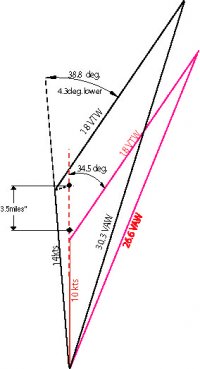Kevlarpirate
Member II
Whoa Silver!!
Seth,
My message was that the J35 was NOT an IOR boat (obviously) . The static curve I have on the J35 shows a static limit of 109 and a very scary ratio of positive vs: negative area (under the curve) of 1.687 , (1987 USYRU). To put into perspective my NPT41 has a static limit of 132 and a very comfortable ratio of 7.5 also produced by USYRU I don’t have reason to doubt them. BTW the Newport was designed in 1970 or earlier. The initial righting moment for the J35 is much higher than the NPT as shown by the slope of the curve.
The righting arm peak of the J35 is at 50 deg., the NPT at 70. So the J is a stiffer boat . But then the J’s curve drops rapidly. In a big sea that’s bad. My point is; I consider the NPT curve MUCH more seaworthy. Considering a design date almost 20 years prior to the J. I think that says a lot.
As for the 1.34 X LWL, all boats are in the displacement mode until they are not, meaning in a transitional state. If you were to freeze the ocean and pluck the boat out of the sea and fill the hole with sea water , that water would weigh the weight of the boat sailing in displacement mode. If you are doing 18 kts in a 70 , I guarantee you are not displacing the weight of the boat in water, (much less) and so I called that planing. The pure definition of planing would be to displace no water at all. I should have said semi planning. As for the polars, Sorcery etc. I still am interested in the upwind VMG. No doubt boat speed is slower but it is a cosine thing.
I don’t know anything about the Clipper cup. But I do have one last thought and that is:
The OCC owns Alaska Eagle (which I meant to say in my first post) They trust the integrity of this 30 year old designed and built boat to go anywhere with passengers, I seriously doubt they would take the same liability with Pyewacket, even if they slowed her down.
KEV
Seth,
My message was that the J35 was NOT an IOR boat (obviously) . The static curve I have on the J35 shows a static limit of 109 and a very scary ratio of positive vs: negative area (under the curve) of 1.687 , (1987 USYRU). To put into perspective my NPT41 has a static limit of 132 and a very comfortable ratio of 7.5 also produced by USYRU I don’t have reason to doubt them. BTW the Newport was designed in 1970 or earlier. The initial righting moment for the J35 is much higher than the NPT as shown by the slope of the curve.
The righting arm peak of the J35 is at 50 deg., the NPT at 70. So the J is a stiffer boat . But then the J’s curve drops rapidly. In a big sea that’s bad. My point is; I consider the NPT curve MUCH more seaworthy. Considering a design date almost 20 years prior to the J. I think that says a lot.
As for the 1.34 X LWL, all boats are in the displacement mode until they are not, meaning in a transitional state. If you were to freeze the ocean and pluck the boat out of the sea and fill the hole with sea water , that water would weigh the weight of the boat sailing in displacement mode. If you are doing 18 kts in a 70 , I guarantee you are not displacing the weight of the boat in water, (much less) and so I called that planing. The pure definition of planing would be to displace no water at all. I should have said semi planning. As for the polars, Sorcery etc. I still am interested in the upwind VMG. No doubt boat speed is slower but it is a cosine thing.
I don’t know anything about the Clipper cup. But I do have one last thought and that is:
The OCC owns Alaska Eagle (which I meant to say in my first post) They trust the integrity of this 30 year old designed and built boat to go anywhere with passengers, I seriously doubt they would take the same liability with Pyewacket, even if they slowed her down.
KEV




